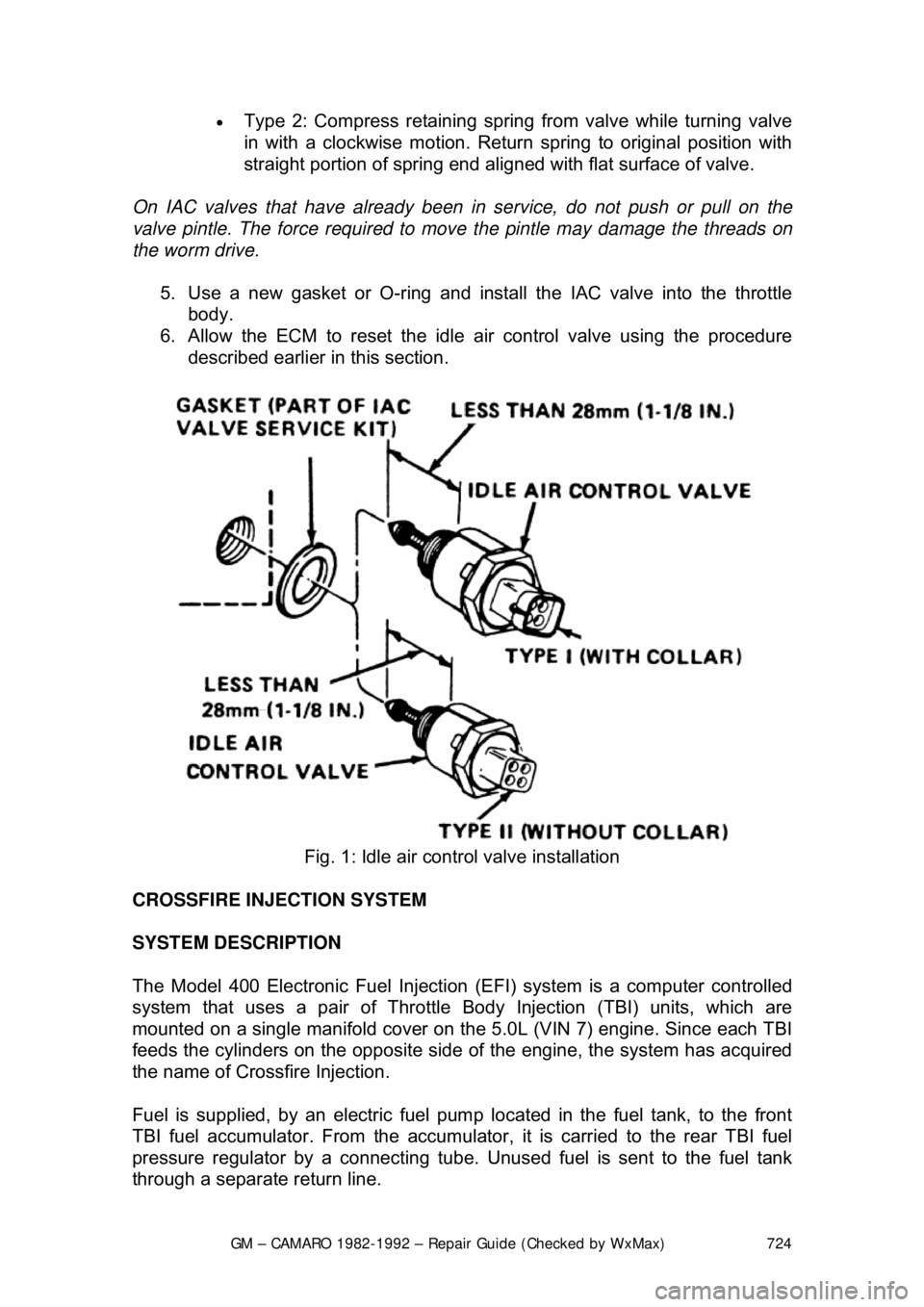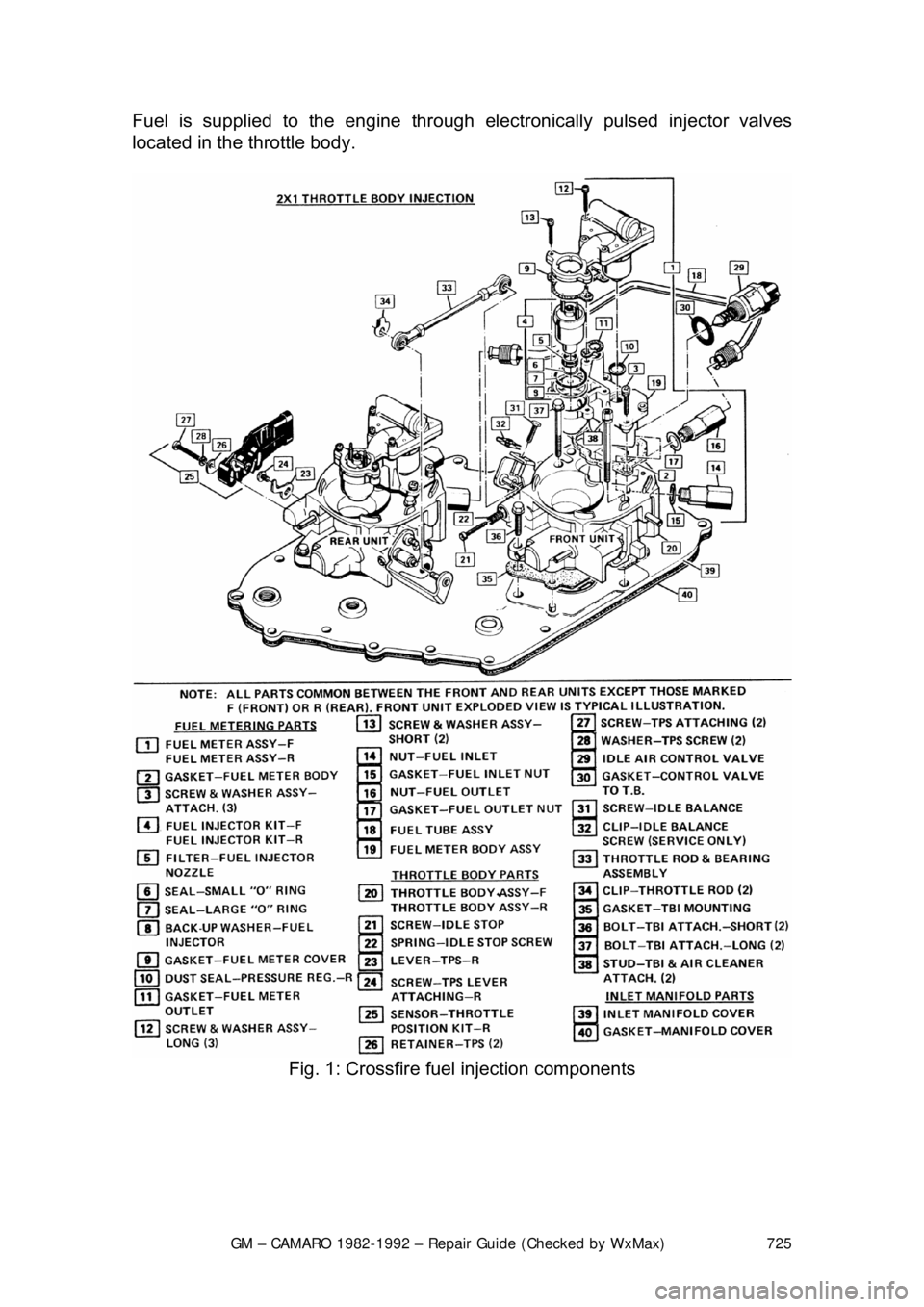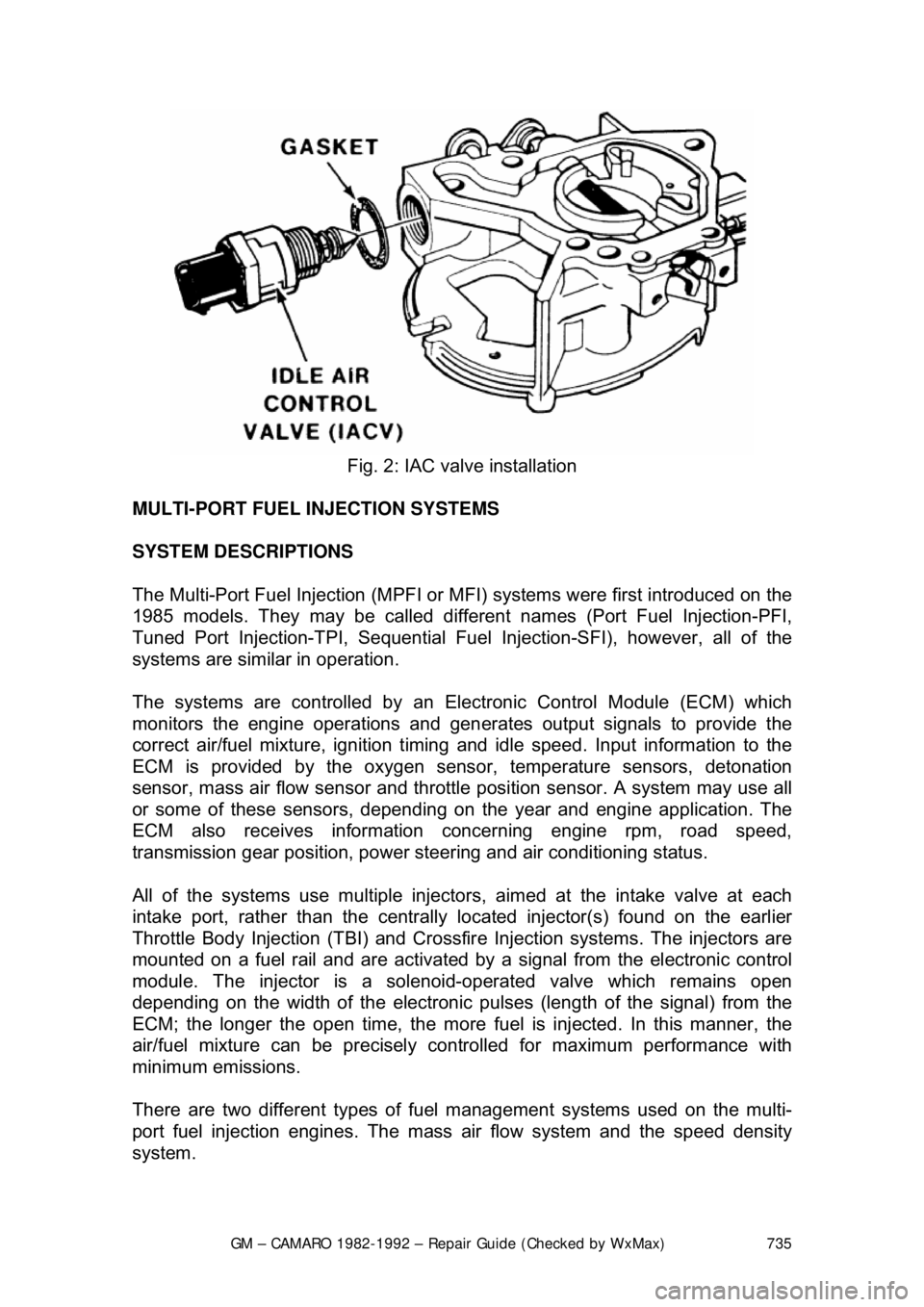1982 CHEVROLET CAMARO check engine
[x] Cancel search: check enginePage 724 of 875

GM – CAMARO 1982-1992 – Repair Guide (Checked by WxMax) 724
•
Type 2: Compress retaining spring from valve while turning valve
in with a clockwise motion. Return spring to original position with
straight portion of spring end aligned with flat surface of valve.
On IAC valves that have already been in service, do not push or pull on the
valve pintle. The force required to move the pintle may damage the threads on
the worm drive.
5. Use a new gasket or O-ring and install the IAC valve into the throttle body.
6. Allow the ECM to reset the idle air control valve using the procedure
described earlier in this section.
Fig. 1: Idle air control valve installation
CROSSFIRE INJECTION SYSTEM
SYSTEM DESCRIPTION
The Model 400 Electronic Fuel Injection (EFI) system is a computer controlled
system that uses a pair of Throttle Body Injection (TBI) units, which are
mounted on a single manifold cover on t he 5.0L (VIN 7) engine. Since each TBI
feeds the cylinders on the opposite side of the engine, the system has acquired
the name of Crossf ire Injection.
Fuel is supplied, by an electric fuel pum p located in the fuel tank, to the front
TBI fuel accumulator. From the accumulator, it is carried to the rear TBI fuel
pressure regulator by a c onnecting tube. Unused fuel is sent to the fuel tank
through a separate return line.
Page 725 of 875

GM – CAMARO 1982-1992 – Repair Guide (Checked by WxMax) 725
Fuel is supplied to the engine through
electronically pulsed injector valves
located in the throttle body.
Fig. 1: Crossfire fuel injection components
Page 726 of 875

GM – CAMARO 1982-1992 – Repair Guide (Checked by WxMax) 726
RELIEVING FUEL SYSTEM PRESSURE
1. Remove the fuse marked "Fuel Pu mp" from the fuse block in the
passenger compartment.
2. Crank the engine. Th e engine will start and run until the fuel supply
remaining in the lines is exhauste d. When the engines stops, engage the
starter again for three seconds to a ssure dissipation of any remaining
pressure.
3. With the ignition OFF, disconnect the negative battery cable to prevent
fuel discharge if the key is accidentally turned to the ON position.
Replace the fuse with the ignition OFF.
When disconnecting fuel lines, there ma y still be a small amount of fuel
released. Cover the fuel line connection wi th a shop cloth to collect the fuel,
then place the cloth in an approved container.
ELECTRIC FUEL PUMP
REMOVAL & INSTALLATION
The removal and installation procedures fo r the Crossfire injection system fuel
pump is identical to the Throttle Body In jection (TBI) system. Please refer to the
TBI fuel pump procedures earlier in this repair guide.
TESTING
The testing procedures for the Crossfire in jection system fuel pump is identical
to the Throttle Body Injection (TBI) syst em. Please refer to the TBI fuel pump
procedures earlier in this repair guide.
THROTTLE BODY
REMOVAL & INSTALLATION
FRONT UNIT
1. Relieve the fuel system pressure.
2. Remove the air cleaner assembly, noting the connection points of the
vacuum lines.
3. Detach the electrical connectors at the injector and the idle air control
motor.
4. Disconnect the vacuum lines from the TBI unit, noting the connection
points. During installation, refer to the underhood emission control
information decal for vacuum line routing information.
5. Disconnect the transmission det ent cable from the TBI unit.
6. Disconnect the fuel inlet (feed) and fuel balance line connections at the
front TBI unit.
7. Remove and discard the throttle cont rol rod retaining clip from the front
TBI throttle lever stud. A new clip must be used during reassembly.
8. Unbolt and remove the TBI unit.
Page 727 of 875

GM – CAMARO 1982-1992 – Repair Guide (Checked by WxMax) 727
To install:
9. Replacement of the manifold cover or either throttle body requires throttle
valve synchronizing and checking of the throttle rod alignment (see
"Preliminary Adjustments"). Before installing the replacement throttle
body unit(s) on the engine, perform the following steps:
a. If the tamper resistant plugs co vering the throttle stop screws are
in place, remove the plugs.
b. If the front TBI unit throttle syn chronizing screw has a welded
retaining collar, grind off the weld.
c. Block possible movement of the throttle lever, relieving the force
of the heavy spring against the throttle synchronizing screw. This
prevents the levers from coming into contact.
If the lever is not blocked before the thro ttle synchronizing screw is removed,
the screw may be damaged, and reinstallation will be accomplished only with
great difficulty.
d. Remove the synchronizing screw and collar. Discard the collar and reinstall the screw. The blocking from the throttle lever (installed in the
previous step) can now be removed.
CAUTION - The collar must be removed to prevent possible interference with
the air cleaner. Failure to do so c ould result in personal injury
10. Use new gaskets and tighten the TB I bolts to 120-168 inch lbs. (13-19
Nm) during installation.
11. Perform the preliminary adjustm ents. These procedures must be
followed before further assembly.
12. Reconnect the fuel lines to the TBI units. Use a backup wrench to
prevent the nuts from tu rning in the TBI unit.
13. Reconnect the throttle cable and detent cable.
14. Reconnect all related vacuum lines.
15. Reconnect the electrical connectors.
16. With the engine OFF, depress the accelerator pedal to the floor and
release. Check for free return of the pedal.
17. Check the throttle position sensor voltage and adjust if necessary.
18. Perform the Minimum Idle and Thro ttle Valve Synchronization adjustment
procedures.
Rear Unit 1. Relieve the fuel system pressure.
2. Remove the air cleaner assembly, noting the connection points of the
vacuum lines.
3. Disconnect the electrical connectors at the injector, idle air control motor,
and throttle position sensor.
4. Disconnect the vacuum lines from the TBI unit, noting the connection
points. During installation, refer to the underhood emission control
information decal for vacuum line routing information.
Page 728 of 875

GM – CAMARO 1982-1992 – Repair Guide (Checked by WxMax) 728
5. Disconnect the throttle and cruise c
ontrol (if so equipped) cables at the
TBI unit.
6. Disconnect the fuel return and bal ance line connections from the rear TBI
unit.
7. Remove and discard the throttle cont rol rod retaining clip from the front
TBI unit throttle lever stud. A new clip must be used during reassembly.\
One throttle rod end bearing is permanently attached to the throttle lever stud of
the rear TBI unit, and must not be remov ed from it. If the throttle rod and
bearing assembly needs replacement, Th e entire rear throttle body must be
replaced.
8. Unbolt and remove the TBI unit.
To install: 9. Replacement of the manifold cover or either throttle body requires throttle
valve synchronizing and checking of the throttle rod alignment (see
"Preliminary Adjustments"). Before installing the replacement throttle
body unit(s) on the engine, perform the following steps:
a. If the tamper resistant plugs co vering the throttle stop screws are
in place, remove the plugs.
b. If the front TBI unit throttle syn chronizing screw has a welded
retaining collar, grind off the weld.
c. Block possible movement of the throttle lever, relieving the force
of the heavy spring against the throttle synchronizing screw. This
prevents the levers from coming into contact.
If the lever is not blocked before the thro ttle synchronizing screw is removed,
the screw may be damaged, and reinstallation will be accomplished only with
great difficulty.
d. Remove the synchronizing screw and collar. Discard the collar and reinstall the screw. The blocking from the throttle lever (installed in the
previous step) can now be removed.
CAUTION - The collar must be removed to prevent possible interference with
the air cleaner. Failure to do so c ould result in personal injury.
10. Use new gaskets and tighten the TB I bolts to 120-168 inch lbs. (13-19
Nm) during installation.
11. Perform the preliminary adjustm ents. These procedures must be
followed before further assembly.
12. Reconnect the fuel lines to the TBI units. Use a backup wrench to
prevent the nuts from tu rning in the TBI unit.
13. Reconnect the throttle cable and the cruise control cable.
14. Reconnect all related vacuum lines.
15. Reconnect the electrical connectors.
16. With the engine OFF, depress t he accelerator pedal to the floor and
release. Check for free return of the pedal.
Page 732 of 875

GM – CAMARO 1982-1992 – Repair Guide (Checked by WxMax) 732
MINIMUM IDLE AND THROTTL
E VALVE SYNCHRONIZING
The throttle position of each throttle body must be balanced so that the throttle
plates are synchronized and open si multaneously. These adjustment
procedures must be followed AFTER performing the "Preliminary Adjustments".
1. Remove the air cleaner and plug the vacuum port on the rear TBI unit for
the thermostatic air cleaner.
2. Remove the tamper resistant pl ugs covering both unit throttle stop
screws, if necessary.
3. Block the drive wheels and apply the parking brake.
4. Connect a tachometer to measure rpm.
5. Start the engine and allo w the engine rpm to stabilize at normal operating
temperature.
6. Have a helper apply the brakes and place the transmission in DRIVE.
7. Plug the idle air pass ages of each throttle body with plugs (J-33047 or
equivalent). Make sure the plugs are seated fully in the passage so that
no air leaks exist. The engine rpm should decrease below curb idle
speed. If the engine rpm does not decreas e, check for a vacuum leak.
8. Remove the cap from the ported tube on the rear TBI unit and connect a
vacuum gauge or water manometer.
9. Adjust the rear unit throttle stop screw to obtain approximately
1/2 in. Hg
as read on the vacuum gauge, or 6 in. H
2O as read on the manometer. If
not able to adjust to this level, check that the front unit throttle stop is not
limiting throttle travel.
10. Remove the vacuum gauge or manometer from t he rear unit and install
the cap on the port ed vacuum tube.
11. Remove the cap from the ported va cuum tube on the front TBI unit and
install the gauge or manomet er as before. If the reading is not the same
as the rear unit, proceed as follows: a. Locate the throttle synchronizing screw and collar on the front TBI
unit. The screw may be welded to discourage tampering with this
adjustment. Break the weld, if ne cessary, and install a new screw
with a thread seali ng compound applied.
b. Adjust the screw to obtain approximately
1/2 in. Hg as read on the
vacuum gauge, or 6 in. H
2O on the manometer.
12. Remove the gauge or manometer fr om the ported tube and reinstall the
cap.
13. Adjust the rear throttle stop screw to obtain 475 rpm, with the
transmission in D and the parking brake applied. On manual
transmission models, leave the gear selector in N.
14. Turn the ignition OFF and pl ace automatic transmission in N.
15. Remove idle air passage plugs.
16. Start the engine. It may run at a high rpm but the engine speed should
decrease when the idle air control va lves close the air passages. Stop
the engine when the rpm decreases.
17. The throttle position sensor (TPS) voltage should be checked and adjusted, if necessary.
18. Connect the vacuum line to the TBI unit and install the air cleaner.
19. Reset the idle speed control motors by driving the vehicle to 45 mph.
Page 733 of 875

GM – CAMARO 1982-1992 – Repair Guide (Checked by WxMax) 733
THROTTLE POSITION SENSOR (TPS)
An accurate digital voltmeter is
needed to perform this adjustment.
1. Remove the air cleaner.
2. Disconnect the TPS electrical connector.
3. Install three jumper wires betwe en the TPS and the TPS wiring terminal
connections.
4. Turn the ignition ON, engine stopped, measure the voltage between
terminals B and C.
5. The display should read between 0.45-0.60 volts.
6. Loosen the screws and rotate the TPS to obtain the correct voltage, if necessary.
7. Tighten the TPS screws and turn the i gnition OFF. Remove the jumpers.
8. Reconnect the wir ing to the TPS.
9. Install the air cleaner.
Fig. 5: TPS adjustment
FUEL PRESSURE REGULATOR
REMOVAL & INSTALLATION
The removal and installation procedures fo r the Crossfire injection system's fuel
pressure regulator is identical to t he Throttle Body Injection (TBI) system.
Please refer to the TBI fuel pressure r egulator procedures earlier in this repair
guide.
THROTTLE POSITION SENSOR (TPS)
REMOVAL & INSTALLATION
1. Remove the air cleaner.
2. Disconnect the electrical connector.
3. Remove the TPS attaching screws and lockwashers.
4. Remove the TPS.
To install:
Page 735 of 875

GM – CAMARO 1982-1992 – Repair Guide (Checked by WxMax) 735
Fig. 2: IAC valve installation
MULTI-PORT FUEL INJECTION SYSTEMS
SYSTEM DESCRIPTIONS
The Multi-Port Fuel Injection (MPFI or MFI) systems were first introduced on the
1985 models. They may be called different names (Port Fuel Injection-PFI,
Tuned Port Injection-TPI, Sequential Fuel Injection-SFI), however, all of the
systems are similar in operation.
The systems are controlled by an Elec tronic Control Module (ECM) which
monitors the engine operations and gen erates output signals to provide the
correct air/fuel mixture, ignition timing and idle speed. Input information to the
ECM is provided by the oxygen sens or, temperature sensors, detonation
sensor, mass air flow sensor and throttle position sensor. A system may use all
or some of these sensors, depending on the year and engine application. The
ECM also receives information concerning engine rpm, road speed,
transmission gear position, power steer ing and air conditioning status.
All of the systems use multiple injector s, aimed at the intake valve at each
intake port, rather than the centrally lo cated injector(s) found on the earlier
Throttle Body Injection (TBI) and Crossfir e Injection systems. The injectors are
mounted on a fuel rail and ar e activated by a signal from the electronic control
module. The injector is a solenoi d-operated valve which remains open
depending on the width of t he electronic pulses (length of the signal) from the
ECM; the longer the open time, the more f uel is injected. In this manner, the
air/fuel mixture can be precisely c ontrolled for maximum performance with
minimum emissions.
There are two different types of f uel management systems used on the multi-
port fuel injection engines. The mass air flow system and the speed density
system.